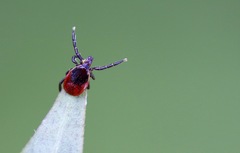The tick pierces the skin and embeds itself using barbed mouthparts. Rapidly pulling out the tick may lead to the barbed mouthparts being retained in the skin. The following photos show the barbed mouthparts in two different species of tick.
Image attributions: Blacklegged tick (palps closed): Susan Ellis via Insect Images, CC BY 3.0 US. Australian paralysis tick (not present in Canada, palps open): Pests and Diseases Image Library via Insect Images, CC BY-NC 3.0 US



